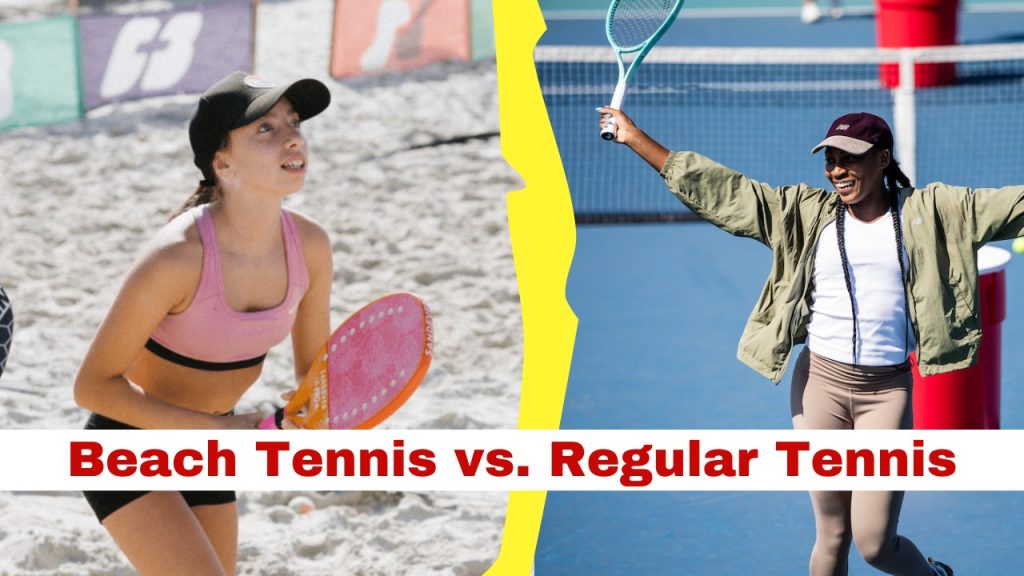
Sports have always been an exciting way to stay fit, have fun, and engage in friendly competition. Among the many racquet sports, tennis has gained immense popularity worldwide. While traditional tennis, often played on hard courts, grass, or clay, is well-known, beach tennis is a newer variation that has been growing in popularity. This article explores the key differences and similarities between beach tennis and regular tennis, making it easier to understand both sports.
Overview of Beach Tennis and Regular Tennis
Beach tennis and regular tennis share many elements, such as racquets, a net, and competitive gameplay. However, they differ in their rules, equipment, and playing surfaces.
Basic Differences Between Beach Tennis and Regular Tennis
| Feature | Beach Tennis | Regular Tennis |
|---|---|---|
| Playing Surface | Sand | Hard court, grass, or clay |
| Court Size | 16m x 8m | Singles: 23.77m x 8.23m, Doubles: 23.77m x 10.97m |
| Net Height | 1.7m (like beach volleyball) | 0.914m (at center) |
| Ball Used | Low-pressure tennis ball | Standard tennis ball |
| Racquet Type | Solid paddle (no strings) | Stringed racquet |
| Scoring System | Similar to regular tennis | Traditional tennis scoring |
| Bounce Allowed | No | Yes |
| Number of Players | 2 (Singles or Doubles) | 2 (Singles) or 4 (Doubles) |
Detailed Comparison
Playing Surface
The most obvious difference between the two sports is the surface. Regular tennis is played on different types of courts, including hard courts, grass courts, and clay courts. The bounce of the ball varies depending on the court type, influencing the pace and style of the game.
On the other hand, beach tennis is played on sand, making movement more challenging. Since the sand absorbs impact, players must rely on agility and quick reflexes rather than speed.
Equipment Used
Regular tennis racquets have strings and vary in weight, balance, and grip. Players select racquets based on their playing style. The tennis ball is made of rubber and covered with felt, allowing it to bounce on the court.
Beach tennis racquets are solid paddles without strings. They are smaller and lighter than regular tennis racquets. The balls used in beach tennis are slightly softer and have lower pressure, preventing them from bouncing off the sand.
Rules and Scoring System
Both sports follow a similar scoring system (15, 30, 40, game), but the way they are played differs significantly.
- In regular tennis, the ball must bounce within the court boundaries before the opponent returns it.
- In beach tennis, the ball cannot bounce at all. Players must hit the ball directly in the air, similar to volleyball.
- The net height is also different. Beach tennis has a higher net, making it more challenging to hit the ball downwards.
Gameplay and Strategy
The gameplay style in each sport varies significantly.
- Regular tennis allows players to use different strategies, such as baseline rallies, volleys, and powerful serves. The bounce of the ball plays a crucial role in shot selection.
- Beach tennis is faster-paced, as players must return the ball before it touches the sand. Since running in sand is harder than on a solid court, players rely more on quick reflexes, positioning, and teamwork.
Physical Fitness Requirements
| Aspect | Beach Tennis | Regular Tennis |
| Endurance | High, due to movement in sand | High, but different muscle use |
| Strength | Upper-body strength important | Leg and core strength needed |
| Speed | Moderate (sand slows movement) | Fast, due to solid surface |
| Agility | Quick reflexes needed | Speed and agility important |
Beach tennis is highly demanding on leg muscles because running on sand is more challenging. Regular tennis requires explosive movements, such as sprinting to reach the ball and making sharp turns.
Popularity and Growth
Regular tennis has been around for centuries and has a strong presence in major tournaments, such as Wimbledon, the US Open, the French Open, and the Australian Open. Players like Roger Federer, Serena Williams, and Rafael Nadal have made the sport globally popular.
Beach tennis, while newer, is growing quickly. The International Tennis Federation (ITF) promotes beach tennis through various international events. It is more common in coastal regions, where beaches provide a natural venue for the sport.
Which One Should You Play?
Choosing between beach tennis and regular tennis depends on various factors:
- If you prefer a traditional, strategic game with a mix of power and precision, regular tennis is the best choice.
- If you enjoy fast-paced, energetic matches that involve quick reflexes and teamwork, beach tennis might be more exciting.
- Location also plays a role. If you live near a beach, beach tennis is an accessible and fun sport.
Final Thoughts
Both beach tennis and regular tennis are fantastic sports that offer unique challenges and benefits. Regular tennis is a well-established game requiring technique, strength, and strategic play. Beach tennis, on the other hand, is a dynamic, social, and physically demanding sport perfect for beach lovers. Whether you choose to play on a hard court or the sandy shore, both sports promise excitement, fitness, and fun!



